Growing up in Scotland: a study following the lives of Scotland's children
The first research report on Sweep 1 findings of the Growing Up in Scotland study.
Chapter 4: Parenting Young Children
4.1 Introduction
Ensuring children have a good start in life is the cornerstone of much cross-cutting government policy. Health for All Children (Guidance on Implementation in Scotland) (Scottish Executive, 2004a) states that 'the rights and responsibilities to provide for their children's health and welfare rest with parents'. This guidance also outlines an approach to child health surveillance, screening and health promotion that effectively targets vulnerable children and families while maintaining universal provision through a staged intervention approach. The need for an integrated approach to support children and families is also the hallmark of other policy initiatives such as Sure Start Scotland which supports vulnerable young children and their families with the aim of improving children's social and emotional development, their health, ability to learn and to strengthen families and communities. The Starting Well National Health Demonstration project aimed specifically to support families with young children living in deprived circumstances and as part of its intensive support scheme piloted a specific parenting education programme (Triple P). Breastfeeding remains a priority with specific targets and recommendations. More broadly, the Scottish Executive's aim to close the opportunity gap between the most advantaged and most deprived requires that children and families receive the help and support that they need and in an appropriate way.
Meeting the needs of parents of young children effectively requires understanding the issues that they confront. This chapter examines parents' experiences of parenting very young children in the period immediately after birth and at the time of the interview. It explores issues including maternity leave, breastfeeding, different problems experienced such as the child's sleeping pattern or health issues, and problems associated with getting on with life whilst coping with the demands of a small child. The two samples are compared throughout the presentation of these results.
4.2 Maternity leave
Mothers who were employed during their pregnancy with the sample child were asked whether they took maternity leave from their job or whether the job finished. Those who took maternity leave were asked a further question about the duration of that leave.
In total, 74% of mothers had a job during their pregnancy with the sample child and the vast majority of this group (85%) took maternity leave from that job (the remainder ended the job completely). The duration of maternity leave taken varied widely across the sample. As Figure 4-A indicates, the majority of mothers in the baby cohort went back to work between six and nine months after the birth, including around half who returned after six or seven months, corresponding with the end of the statutory maternity leave period at that time. Notably, a quarter of mothers returned to work when their baby was less than six months old, including 4% who returned when the sample child was less than
3 months old.
Figure 4-A Number of months of maternity leave (baby cohort only)
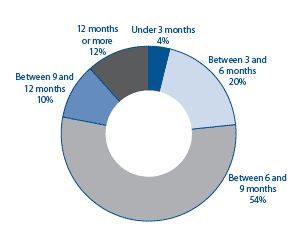
The length of maternity leave varied considerably by the socio-economic classification of the household and by household income. Not surprisingly, women in managerial and professional households tended to take more maternity leave - 11% taking between nine and 12 months maternity leave compared with 5% of women in households classed as routine or semi-routine (Figure 4-B). By contrast, 9% of women in households classed as routine and semi-routine went back to work when their baby was less than three months, compared with 3% of those in managerial and professional households. Household income was also a powerful predictor of length of maternity leave: two-fifths of mothers in the lowest household income bracket returned to work before their baby was six months old, compared with a quarter in the highest household income bracket.
Figure 4-B Number of months of maternity leave taken by household NS-SEC
4.3 The first three months
4.3.1 Coping as a couple in the first six weeks
Respondents were asked how well they felt that they and their partner had dealt with the cohort child's arrival in the six weeks after the birth. 11 Across both cohorts, over nine in ten felt they coped very or fairly well with the child's arrival (94% babies, 92% toddlers). But as might be expected, again across both cohorts, first-time mothers were less likely than those with other children to feel that they had coped 'very well'.
4.3.2 Child-related problems in the first three months
Table 4.1 shows responses to a series of questions about a range of issues that parents may have faced with their child in the first three months after the birth. The most common problems, across both cohorts, were wind or colic. Just under half of the parents of babies (47%) and 41% of toddlers' parents indicated that these ailments had been either 'a bit of a problem' or 'a big problem'. The child's sleeping pattern was the next most common issue considered to be problematic, again across both cohorts. Allergies and asthma were least likely to have caused problems for parents in the first three months of the child's life. There were no significant differences between the two cohorts.
Table 4.1 Extent of problems experienced in the first three months after the cohort child was born by sample type
| Problem description |
Sample type (%) |
|
|---|---|---|
| % reporting as a 'big problem' or a 'bit of a problem' |
Babies |
Toddlers |
| Managing the relationship between the child and his siblings |
25.0 |
21.7 |
| The child suffering from wind or colic |
47.0 |
41.2 |
| The child's sleep pattern |
37.7 |
37.4 |
| Getting the child to feed |
17.1 |
20.0 |
| The child's teething |
17.1 |
13.1 |
| The child suffering from allergies or asthma |
7.2 |
11.2 |
| The child suffering from other health problems |
17.4 |
15.6 |
| Bases |
||
| Weighted |
5217 |
2858 |
| Unweighted |
5217 |
2858 |
Approximately three-quarters of parents in each cohort reported that at least one of these issues had been a problem in the first three months of the child's life (77% babies, 73% toddlers - see Figure 4-C); but the vast majority in both cohorts identified only one or two issues as problematic and were more likely to report these as minor rather than major issues. Indeed, of all those identifying any problems, fewer than half reported any 'big' problems (55% babies, 54% toddlers).
There were no differences between younger and older mothers in terms of their propensity to report any problems, although the former were more likely to report at least one 'big' problem. Mothers educated to degree level were more likely than those with no qualifications to report issues as problematic (in the toddler sample, 80% compared with 63%).
Figure 4-C Number of child-related issues reported to be a bit of or a big problem in first three months 12
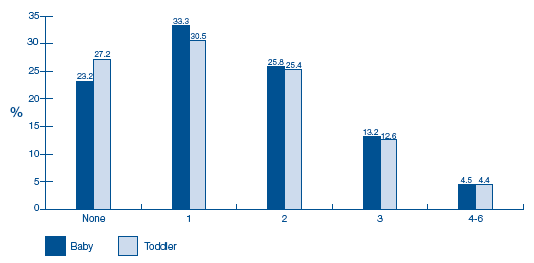
Parents of male children were slightly more likely than parents of female children to report at least one concern in the first three months (77% vs 73%) and to report a greater number of concerns. Parents of male babies were also more likely to report problems with allergies or asthma (this pattern was not evident in the toddler sample) and, furthermore, within both cohorts, male children were significantly more likely to be reported as having had a problematic sleeping pattern in the first three months.
Figure 4-D details which issues caused parents the most concern in the first three months. Not surprisingly, problems associated with wind/colic and the child's sleep pattern emerged as key here.
Figure 4-D Problem causing most concern in first three months (where more than one problem was reported) by sample type
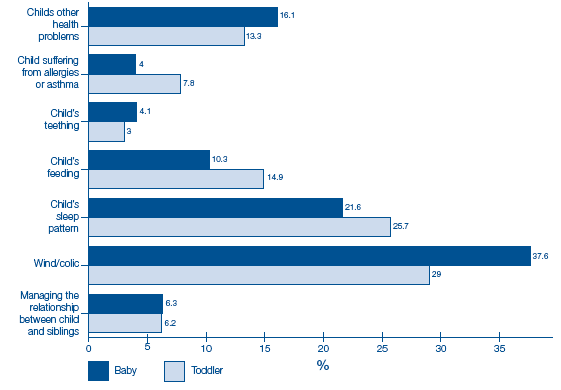
4.3.3 Other problems in the first three months
As well as questions about problems specifically related to the child, respondents were asked to what extent other issues - being able to afford the necessary baby clothes and equipment, managing the house and other domestic responsibilities, and lack of suitable transport - had been a problem for them in the three months following the cohort child's birth (Figure 4-E). Managing the house and other domestic responsibilities emerged as the most important issue in both samples, although most considered this to be a minor, rather than a major problem.
Figure 4-E Issues considered to be a 'bit of' or a 'big problem' in the first three months after cohort child's birth by sample type
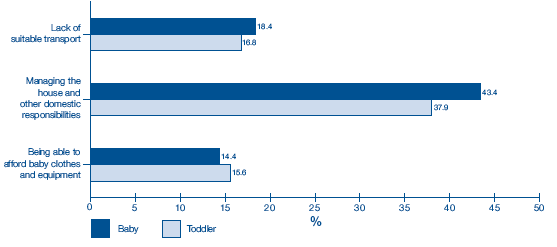
Table 4.2 shows the ten most common problems cited by parents in response to an open question about anything else they found difficult in the three months following the cohort child's birth. Around one in five respondents reported at least one further problem, with lack of sleep being the most frequently cited.
Table 4.2 Ten most common other problems experienced in the first three months after the cohort child was born by sample type
| Problem description |
Sample type (% of those who reported other problems) |
|
|---|---|---|
| Babies |
Toddlers |
|
| Lack of sleep |
17.4 |
14.4 |
| Respondent or partner's health |
9.2 |
8.6 |
| Getting used to having a baby around |
8.6 |
7.1 |
| Child's health |
7.4 |
8.5 |
| Coping with the demands of more than one child |
7.0 |
6.7 |
| Depression and/or other mental health problems |
7.2 |
11.2 |
| Demands of and/or trying to cope with a baby |
6.1 |
3.2 |
| Accommodation or housing problems |
5.9 |
5.1 |
| Problems related to breastfeeding |
5.6 |
6.2 |
| Respondent lost control of own life and/or own time and space |
5.5 |
3.8 |
| Bases |
||
| Weighted |
1123 |
640 |
| Unweighted |
1129 |
641 |
Among those citing 'other problems', almost one in ten indicated that their own or their partner's physical health was an issue in the first three months. Mental health issues were also mentioned, particularly by parents in the toddler sample; almost one in ten (who reported other problems) indicated that depression and/or other mental health difficulties were of concern. This represents 3% of all the toddler parents as a whole.
4.4 The current situation
4.4.1 Sleeping
At the time of interview, similar proportions of parents in each cohort said their child slept through the night every night - just under half of babies (48%) and just over half of toddlers (52%). However, parents of babies were significantly more likely than parents of toddlers to report that their child never slept through the night (20% compared with 13%). Among babies, there were some significant differences between the sleeping habits of boys and girls. Boys had generally less settled sleeping patterns than girls and were more likely to wake during the night. Around a quarter (23%) never slept through the night, compared with 17% of female babies. By the time they reached the toddler stage this distinction had evened out and there were no significant differences between sexes.
On average, babies slept for longer than toddlers in a typical 24-hour period. Only 17% of babies slept for less than 12 hours per day, including sleeps or naps during the day, compared with 41% of toddlers. The majority of children in each cohort (70% for babies, 58% for toddlers) slept for between 12 and 14 hours. There were no significant gender differences in either cohort.
Parents were also asked how many hours sleep at night they were currently getting. A little over three-quarters in each cohort said they were getting between 6 and 8 hours of sleep per night. Only a small proportion (8%) were getting less than 6 hours sleep per night.
4.4.2 Child-related problems at the time of interview
Respondents were again asked to what extent a range of issues, reflecting the current age of the cohort children, were problematic in the three months immediately preceding the interview (see Table 4.3).
The most common problem for the parents of babies at this stage was teething, cited as a problem by just over half of those interviewed. The child's sleep pattern was also a concern for parents of babies, with a third considering this to be a problem. Toddlers' parents, on the other hand, were most likely to report problems with the child's eating habits, closely followed by problems with managing the child's relationship with his/her siblings. Sleeping habits were also a key problem for toddlers' parents, although to a slightly lesser extent than for the parents of babies.
Table 4.3 Extent of problems experienced in the three months prior to interview by sample type
| Problem description |
Sample type (%) |
|
|---|---|---|
| % reporting 'a bit of' or 'a big' problem to do with |
Babies |
Toddlers |
| Managing the relationship between the child and his siblings |
17.3 |
32.5 |
| The child's sleep pattern |
33.1 |
28.9 |
| Getting the child to feed |
13.6 |
35.1 |
| The child's teething |
52.8 |
3.2 |
| The child suffering from allergies or asthma |
10.1 |
15.7 |
| The child suffering from other health problems |
15.9 |
12.9 |
| The child's behaviour towards other children |
N/A |
16.4 |
| The child's behaviour generally |
N/A |
23.9 |
| Bases |
||
| Weighted |
5217 |
2858 |
| Unweighted |
5217 |
2858 |
Three-quarters of respondents in each cohort (74% babies, 75% toddlers) reported at least one of the selected issues as having been a problem in the three months prior to interview, marking no significant change from the situation in the three months immediately after the child's birth. Again, the vast majority of parents reported only one or two of the issues to have been a problem (with relatively small differences between cohorts, despite toddler parents being questioned about two additional issues) and, as before, parents in both cohorts were more likely to identify issues as minor than major problems.
In both cohorts, mothers with a degree or equivalent were again more likely than mothers with lower or no academic qualifications to report at least one of the issues to be problematic. Mothers with higher educational qualifications were also more likely than other mothers to report any and a greater number of problems.
Younger mothers (those aged under 20 at the time of the child's birth) were least likely to report problems with their child's sleep pattern (26% doing so, compared with 39% in the oldest group). Parents of boys continued to report more concerns about their child. Parents of male toddlers were significantly more likely to report problems with the child's behaviour than parents of female toddlers, but this was the only significant gender distinction for the toddler sample across all the issues covered.
4.4.3 Other problems at the time of interview
Figure 4-F shows the proportions of parents within each cohort who considered non-child-related issues to have been problematic in the three-month period before the interview. Again, managing the house and other domestic responsibilities emerged as the key issue for parents in both samples although, again, most did not regard this to be a major problem. Lack of suitable transport and managing the house were less problematic than they were in the period immediately after the birth. However, being able to afford baby clothes and equipment appears to be more problematic at the later stage than earlier. Fifteen percent of baby parents reported a problem with being able to afford baby clothes and equipment in the first three months compared with almost 22% at the time of the interview.
Figure 4-F Extent of non child-related problems in the first three months after cohort child's birth by sample type
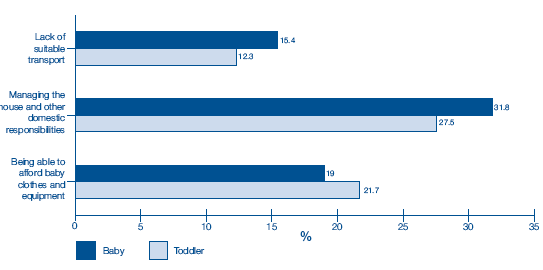
Parents were again asked an open question about anything else they had found difficult in the three months leading up to the interview. Slightly fewer respondents indicated further problems for this period - around 15% (15% babies, 17% toddlers) overall compared with around 20% for the period immediately after birth. The detail of the ten most common other problems reported is displayed in Table 4.4.
Table 4.4 Ten most common other problems experienced in the three months prior to interview by sample type
| Problem description |
Sample type (% of those who reported further problems) |
|
|---|---|---|
| Babies |
Toddlers |
|
| Balancing work and caring for child |
14.1 |
9.4 |
| Childcare (including cost and availability) |
13.2 |
17.4 |
| Accommodation/housing problems |
9.1 |
4.9 |
| Child's behaviour and/or development (including potty/toilet training) |
8.9 |
24.2 |
| Problems related to respondent/partner going back to work |
8.8 |
4.8 |
| Money/finances |
7.9 |
9.4 |
| Relationship difficulties between child's carers |
5.7 |
4.1 |
| Demands of and trying to cope with a child |
5.2 |
4.9 |
| Respondents' lack of sleep/sleep pattern/tiredness |
4.9 |
1.8 |
| Demands of caring for more than one child |
4.6 |
2.9 |
| Bases |
||
| Weighted |
778 |
478 |
| Unweighted |
775 |
479 |
Four issues remain from the earlier list of other problems - lack of sleep, coping with the demands of a child or more than one child, and accommodation and housing. In general, the types of problems reported by parents in each cohort were similar. However, as the data in the table show, the balance of individual problems at the two points in time was quite different: for parents of babies the most significant other issues at the time of interview were related to maintaining a suitable work/life balance, and (the related) problems with arranging suitable childcare. Childcare was also a significant problem for a number of toddlers' parents, although more problematic for this group were issues related to the child's behaviour and their current stage of development. A quarter of toddlers' parents who reported a further problem mentioned this issue. Potty/toilet training in particular was a common response by toddlers' parents on this theme.
4.5 Breastfeeding
4.5.1 Intended and actual breastfeeding
Respondents were first asked how they had intended to feed the child when he or she was born. Across both cohorts, a little under two-thirds (63%) indicated that they had planned to breastfeed. The majority of the remainder indicated that they planned to bottle feed, with only a small proportion having no strong preference at that time.
The intention to breastfeed varied significantly across key-subgroups and particularly in relation to age of mother at the time of birth. As Figure 4-G very clearly demonstrates, younger mothers were much less likely than older mothers to have planned to breastfeed: indeed, mothers aged 40 or over were almost twice as likely as those under 20 to say that they had intended to do so.
Figure 4-G Intention to breastfeed by sample type and age of mother at birth of cohort child
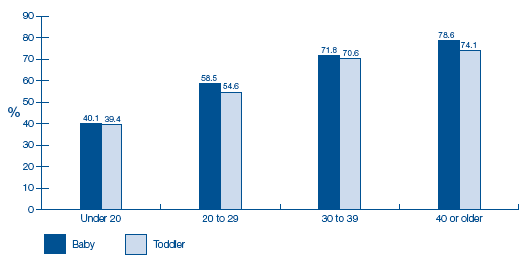
Higher intention rates were also reported by mothers from couple families, first-time mothers, and among mothers with a degree-level qualification and those in full-time employment. For example, within the baby sample, 86% of mothers with a degree or equivalent reported that they intended to breastfeed compared with 48% of those with standard grades or equivalent, and 35% of those with no qualifications. Relatedly, intention to breastfeed was also more common in higher income households and among respondents in more affluent areas. Among the toddler cohort, four out of five (80%) mothers in the least deprived areas indicated an intention to breastfeed compared with just over two in five mothers (43%) in the most deprived areas.
Around 60% of children in both cohorts were ever actually breastfed, including colostrum in the first few days (60% babies, 59% toddlers). The patterns relating to intention to breastfeed at all, as might be expected, are repeated in these data. GUS data on breastfeeding is slightly lower than that collected by the Millennium Cohort Study. For the whole of the UK, MCS reports that 67% of babies were ever breastfed, with a comparable figure of 65% for the Scottish sample.
Figure 4-H shows the prevalence of breastfeeding by area deprivation. For both cohorts, the proportion of children actually breastfed in the areas of lowest deprivation was almost twice as high as that in areas of highest deprivation.
Almost nine in ten mothers who indicated an intention to breastfeed actually did so (88% babies and toddlers). Older mothers who indicated an intention to breastfeed were more likely to actually do so: three-quarters of mothers aged under 20 at the time of the child's birth who intended to breastfeed actually did so compared, with 90% of mothers in their thirties.
Figure 4-H Cohort children actually breastfed by sample type and area deprivation quintiles
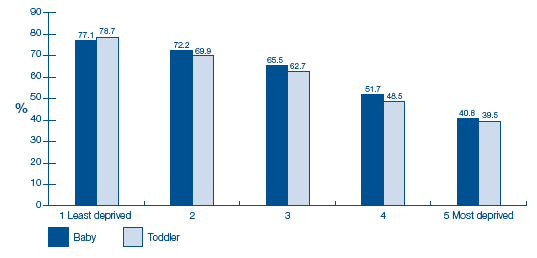
In the baby sample, around one in five (18%) children who were ever breastfed were still being breastfed at the time of the interview (i.e. aged approximately 10.5 months). Of the remainder, 35% of mothers stopped breastfeeding in the first month (including 20% who stopped in the first week), 25% between the first and third months, 14% between three and five months, and 27% at or after six months but before the interview (which took place when the child was aged between 10 and 12 months).
In Scotland, data on national breastfeeding rates are collected by the National Health Service as part of the Child Health Surveillance Programme: Pre-School system. 13 These data show that for babies born in 2005, 38% of mothers were breastfeeding their babies at 6-8 weeks. Directly comparable data is not available for GUS. However, GUS data do indicate that 43% of mothers in the baby cohort were breastfeeding their babies at 1-2 months.
The length of time that mothers breastfed matched the patterns identified in relation to intentions to and actual breastfeeding: namely, older mothers, those with a degree-education, those in couple families, those living in less deprived areas and those in higher income households were likely to breastfeed for longer (see Figure 4-I). Over half (55%) of mothers aged under 20 did not breastfeed beyond the first month and only 8% were still breastfeeding at six months. In comparison, although 31% of mothers in their thirties did not breastfeed beyond the first month, a third (33%) were still breastfeeding at six months.
Overall, then, we have a situation in which experiences of breastfeeding are highly socially-patterned. Not only are certain sub-groups less likely to plan to breastfeed at the outset, they are less likely to actually do so and less likely to do so for an extended period of time.
Figure 4-I Period for which child was breastfed by age of mother at birth of cohort child
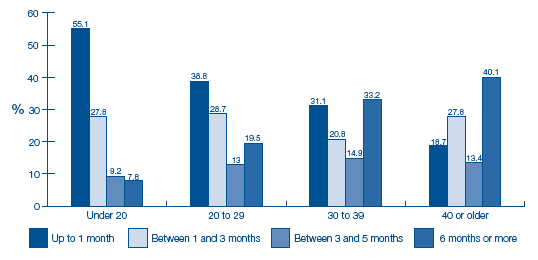
4.5.2 Information and support about breastfeeding
Three-quarters of all respondents, whether they breastfed or not, indicated that they had received help or advice about breastfeeding at the time of the child's birth, with first-time mothers significantly more likely to have received help or advice - 83% of primaparous mothers received help or advice compared with 65% of multiparous mothers. As might be expected, mothers who indicated that they had planned to breastfeed were more likely to have received help or advice than mothers who planned to bottle-feed. Nevertheless, 58% of those who planned to bottle-feed reported that they received some help or advice about breastfeeding.
Midwives were by far the most common source of help or advice about breastfeeding: in each cohort, nine out of ten mothers who received advice about breastfeeding did so from a midwife, with about a third receiving help or advice about breastfeeding from their health visitor, and one in ten from another health professional such as a nurse or doctor or as part of a breastfeeding clinic set up in the hospital (see Table 4.5). The 'Getting off to a good start leaflet' was more commonly mentioned by the mothers of babies than toddlers, although only small proportions of each mentioned it at all and virtually no use was made of other paper literature on the topic. A small number of mothers received advice from the National Childbirth Trust or another voluntary organisation and an even smaller proportion received informal support from family or friends.
The majority (60%) of those who reported receiving help or advice did so from only one source. Around a third received help from two sources and 10% from three or more sources. Not surprisingly, those who had planned to breastfeed, actually breastfed, or breastfed for longer periods of time were more likely to have received help or advice from a larger number of sources.
Table 4.5 Sources of help and advice on breastfeeding by sample type
| Problem description |
Sample type (% of those who received advice about breastfeeding) |
|
|---|---|---|
| Babies |
Toddlers |
|
| Midwife |
92.4 |
90.3 |
| Health visitor |
31.8 |
35.2 |
| Other health professional |
12.7 |
11.2 |
| Getting off to a good start leaflet |
8.8 |
4.3 |
| National Childbirth Trust |
2.0 |
1.1 |
| Other voluntary group or organisation |
2.8 |
2.6 |
| Books, magazines or other leaflet |
0.4 |
0.4 |
| Friend(s) |
0.8 |
1.3 |
| Family members |
1.5 |
1.8 |
| Other specific |
0.8 |
0.4 |
| Bases |
||
| Weighted |
3808 |
2070 |
| Unweighted |
3825 |
2068 |
4.5.3 Weaning and solids
Current guidance from NHS professionals is that most babies can start to have solid food at around six months of age and that solids should not be introduced before four months. Almost all parents (99%) in the baby cohort reported that their child was regularly eating solids at the time of the interview. The vast majority of parents (84%) did not introduce solids until the child was aged at least four months. Two-fifths of babies' parents (44%) started their child on solids at four months, a further fifth (21%) at five months. By six months, 96% of children in the baby cohort were regularly eating solid foods. Comparing results from GUS with trends evidenced in the report of the 2000 Infant Feeding Survey (Hamlyn et al, 2002) suggest that parents' introduction of solids to their childrens' diets has become later in the five years between the surveys, reflecting a progressive trend already identified in that data. Results from the feeding survey indicated that, in 2000, 28% of Scottish parents had introduced solids before their child was aged four months and 55% of parents started their child on solid foods at four months (compared with 16% and 44% for GUS parents respectively).
The point at which solids were introduced varied across sub-groups with lone parents, younger mother and bottle-feeding mothers introducing solids earlier than older mothers, those in a couple family and those breastfeeding. One in four mothers aged under 20 introduced solids before four months, compared with one in ten mothers in their 30s. Among those babies who were breastfed, those breastfed for shorter periods of time were more likely to be introduced to solids at an earlier point: 17% of babies breastfed for up to one month were eating solids before four months compared with only 4% of babies breastfed for six months or longer.
4.6 Parent-child attachment
Parents were asked a range of questions about the type of feelings they have when they are caring for their child. 14 Table 4.6 shows that most parents felt close to their child, although attachment appeared to be slightly stronger between parents and children in the baby cohort than in the toddler cohort. Only a very small proportion of parents felt irritation, resentment or a lack of confidence when they were with their child.
Table 4.6 Assessment of parent-child attachment by sample child
| Sample type (%) |
||
|---|---|---|
| Babies |
Toddlers |
|
| When I am caring for my child I get feelings of annoyance or irritation |
2.0 |
5.1 |
| When I am not with my child I find myself thinking about him/her |
70.9 |
63.8 |
| When I have to leave my child I often/always feel rather sad |
49.9 |
39.7 |
| When I am caring for my child I feel very/fairly incompetent and lacking in confidence |
4.3 |
5.7 |
| Usually when I am with my child I am very/fairly impatient |
7.4 |
10.9 |
| Thinking about the things I had to give up because of my child I find that I resent or mind it a lot/a fair amount |
2.1 |
2.3 |
| Bases |
||
| Weighted |
5187 |
2841 |
| Unweighted |
5188 |
2843 |
4.7 Key points
- The vast majority of couples felt that they had coped well with the child's arrival.
- In the first three months after the birth, problems with wind or colic and the baby's sleeping patterns were the most often cited child-related difficulties. Managing the house and domestic responsibilities was cited as the most common non-child-related problem at this time. By the time of the interview, financial problems associated with purchasing clothes and equipment were a greater concern for parents.
- Key child-related issues at the time of the interview varied by cohort: in relation to babies, teething and sleep patterns were most likely to be seen as a bit of or a big problem whereas for toddlers, the most commonly mentioned problems related to the child's eating habits and managing the relationship with his or her siblings.
- Across both cohorts, around two-thirds of mothers indicated that they had originally intended to breastfeed their child. Sixty percent of children in the study were actually breastfed.
- Feeding practice varied by maternal age and social position with older mothers, those in higher income households and those with higher levels of educational qualifications much more likely to have intended to breastfeed, to have done so at all, and to have still been breastfeeding at 6 months.
- By the age of 6 months, 96% of babies were regularly eating solid foods. Babies born to lone parents and in less affluent households and areas were more likely to have been introduced to solids at an earlier point.
4.8 Conclusion
There is much in the evidence presented in this chapter that is positive in relation to parenting young children. Most importantly, parents (in a relationship with each other) seem to feel that they have coped reasonably well with their child's arrival, although this is more the case for those with a child already. Many child related issues reported at the time of interview were considered to be minor, such as teething or sleeping, suggesting that parents are coping with these and that they are part and parcel of everyday life with very young children. Nonetheless, parents do feel that aspects of their children's health and behaviour can be a problem. Interestingly, older mothers and those from more affluent areas were more likely to report the child's sleeping pattern to be a problem as were mothers with higher educational qualifications.
Breastfeeding rates are highly socially patterned in the samples. Although the majority intended to breastfeed, actually breastfeeding was more common among older mothers, those in higher income households and those with higher educational levels. Early weaning was more common among lone parents and those in less affluent households or areas. Policy and practice challenges clearly remain in terms of promoting and supporting breastfeeding among the more deprived groups in Scotland.
There is a problem
Thanks for your feedback